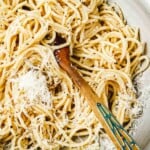Cacio e Pepe
Rome’s classic pasta just takes is a little practice and some elbow grease to make a luscious, cheesy sauce with no heavy cream or butter necessary. I prefer combining everything in the pot, which is less messy and gives you plenty of space to stir vigorously. (See notes for the paste method if you'd like to give that a whirl instead.) Spaghetti and tonnarelli are my two favorite shapes, but rigatoni and bucatini (fat, hollow noodles) also work well here.
Servings: 6
Ingredients
- 2 teaspoons kosher salt
- 1 pound spaghetti, tonnarelli or bucatini pasta
- 4 ounces Pecorino Romano cheese, finely grated
- 1 tablespoon whole peppercorns
Instructions
- Salt the water: Fill a large pot with just enough water to submerge the pasta. Use a little less water than you normally would so the water will be extra starchy as the pasta cooks.
- Boil the pasta: Add the pasta to the boiling water, reduce heat to medium high and cook according to package instructions until the pasta al dente.
- Grate the cheese: While the pasta is cooking, grate the cheese with a microplane or on the small star holes of a box grater. You should have about 3 cups of very fluffy cheese.
- Toast and grind the peppercorns: In a small skillet set over medium-high heat, add the peppercorns. Toast, stirring occasionally or just until they release their aroma. Cool slightly, then transfer them to a mortar or a spice grinder. Pound or grind the peppercorns to a mostly coarse grind with some finer specks but no large pieces.
- Drain and reserve pasta water: When the pasta is done, set a colander over a bowl, and drain the pasta. You want to reserve 1 1/2 cups of the boiling pasta water in a heat-proof measuring cup or bowl.
- Make the sauce: Do this part quickly! Return the pasta to the cooking pot and add 1/3 cup reserved pasta water. Set the pot on the burner but don’t turn the burner on. Sprinkle about 1/3 of the cheese, 2 teaspoons pepper, and a splash of the reserved pasta water. Use tongs or a pasta spork to stir vigorously to combine the ingredients. Add another splash of reserved pasta water and another 1/3 of the cheese and continue to stir to coat the noodles evenly. The sauce should look smooth and creamy. Add more cooking water, a splash at a time (if necessary) to loosen the sauce. You may not use all of the pasta water.
- Serve: Transfer the pasta to individual bowls. Top each serving with a spoonful of reserved pecorino and a pinch of pepper and serve.
Video
Notes
- Shop this recipe: Visit our shop to browse quality Mediterranean ingredients, including the pasta used in this recipe.
- For the paste method:
- Combine 2/3 of the grated cheese with the pepper and enough hot pasta water to create a paste. Whisk to work out any lumps, adding more water to help melt and dissolve the cheese.
- Using a pasta server or tongs, transfer the noodles from the pot straight to the bowl and stir vigorously to coat the noodles. Add more pasta water from the pot as needed to make a creamy sauce.
- What to do with leftovers: Leftover cacio e pepe makes an excellent spaghetti frittata! Mix the leftover pasta with beaten egg, then cook in an oiled cast iron skillet until browned on the bottom. Pass it under the broiler for a couple of minutes to finish cooking and brown the top.
Nutrition
Calories: 357.8kcal | Carbohydrates: 58.2g | Protein: 16g | Fat: 6.3g | Saturated Fat: 3.5g | Polyunsaturated Fat: 0.6g | Monounsaturated Fat: 1.6g | Cholesterol: 19.7mg | Sodium: 1006.8mg | Potassium: 207.1mg | Fiber: 2.8g | Sugar: 2.2g | Vitamin A: 87.6IU | Calcium: 224.8mg | Iron: 1.3mg
QR code
Scan this QR code with your phone's camera to view this recipe on your mobile device.
